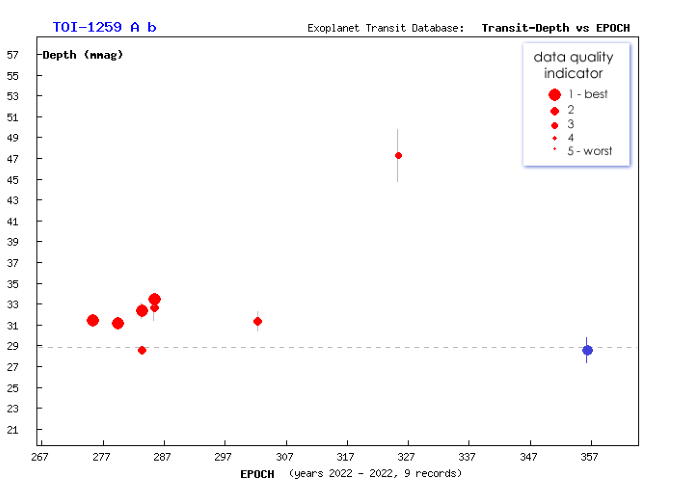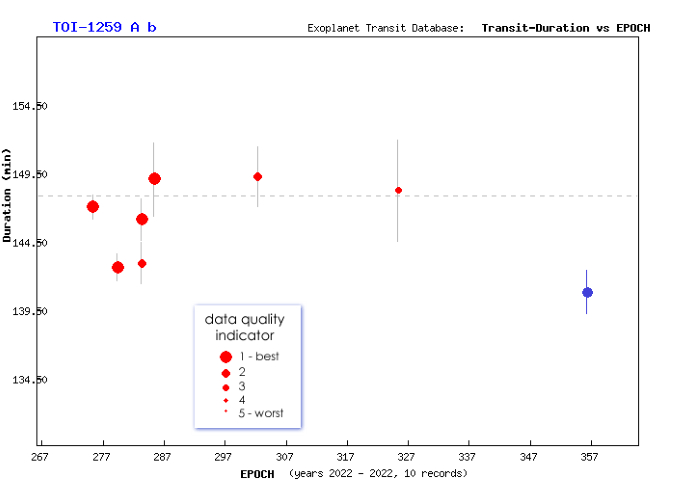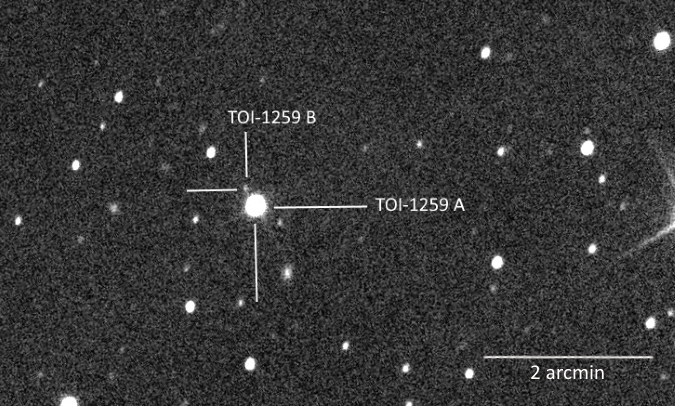Dr. Gerold Holtkamp, 2022.12.22
The transit light curve of the exoplanet TOI-1259 A b, discovered just two years ago, was measured. The data determined agree well with literature values. It is a double star system, which is additionally interesting. The close position at the north celestial pole allows interesting further observations of TOI-1259 A b . The data determined agree well with literature values. It is a double star system, which is a special feature. The close position at the north celestial pole allows interesting further observations.
Admittedly, the name isn't particularly spectacular and doesn't stimulate the imagination either. But the fact that this alien planet was discovered just two years ago in 2020, although it orbits the star TOI-1259 A at a distance of not more than 385 light-years from us, is remarkable. But the volume of space and thus the number of stars increase enormously with distance. A lot of undiscovered things can be hidden there. Even if we amateurs cannot be the discoverers, it is still very attractive for us to be able to follow such a planet discovery so close behind the professionals - with our own device, from a garden near the city - unthinkable 30 years ago. If you can prove it yourself and it's not just reeding it in leterature, that's a different quality of experiencing astronomy.
The Observation Object
The exoplanet TOI-1259 A b was not discovered until 2021. This is the release date. The actual discovery was probably made in 2019. The parent star TOI-1259 A is a star with a radius 0.71 times and a mass 0.68 times of our Sun and a surface temperature of 4800 K, which appears 12.1 mag bright to us on Earth. The exoplanet TOI-1259 A b is a so-called hot Jupiter, i.e. it has 0.44 times Jupiter's mass and 1.02 times its diameter. The surface temperature of 963 K determines its name. It orbits its parent star in an amazing 3.48 days at a distance of just 6 million km (major axis). It produces an obscuration of 29 mmag on its transit. There is a stellar companion, TOI-1259 B, which is gravitationally bound to the main star at about 1600 AU (0.025 LY). It appears to us at about 19 mag [1] [2].
The system is very interesting as an observation object:
- Until a few years ago, it was not thought possible for an exoplanet to have a stable orbit in a binary star system.
- For amateur devices, the parent star has sufficient brightness and high transit obscuration.
- The brightness of the parent star makes the system a possible candidate for studies of the planetary atmosphere with space telescopes such as Hubble or James Webb.
- And finally, the circumpolar position in the constellation Draco is of great advantage because it allows year-round observation.

The Measurement
The data predicting the transit of TOI 1259 A b in front of its parent star were taken from the Swarthmore College Transitfinder database [4].

A look at the sky in the late afternoon of December 14, 2022 and the weather forecast also promised that it would be a clear night. However, temperatures of -9° Celsius should be reached. In addition, there was a lot of moisture in the air. So it was a matter of preparing yourself and the equipment for it. Warm clothing and a lens heater for the Guidescope were a must. During the course of the measurements (> 4 hours), the telescope and the mount were very heavily covered with hoarfrost, but the camera, guide scope and, above all, the main and secondary mirrors of the telescope remained fog-free during operation. The moon rose at 21:20 UTC and was 70% illuminated but 83° from the observed object.

The equipment used was:
- Teleskop: Newton, 250 mm Öffnung, 1200 mm Brennweite [5]
- Mount: AZ-EQ6 GT Pro
- Control software: SynScanPro, Stellarium
- Camera: QHY268M
- Recording software: AstroArt 8
- Filter: L Antlia Pro
- Guiding: refractor, 50 mm aperture, 180 mm focal length
- Guidingsoftware: PHD Guiding 2
Recordings were made:
- 240 lights with 60 s each (17:56 to 22:15 UTC)
- 10 Darks
- 10 Flats
- 10 Bias
The settings were gain 60, bias 20 and the temperature of the recording chip -12°C, but this dropped to -13.8°C during the night. The brightness of the stars was checked with AstrArt 8. The evaluation of the recordings was done with MuniWin 2.1.
The results
The measurement results were entered both in the database of the AAVSO (American Association of Variable Star Observers) [3] and in the ETD (Exoplanet Transit Database) of the Czech Astronomical Society [6][7]. With ETD, not only is a compensating curve calculated, but data determined from the measured values are also given.

The values calculated by ETD from the measurement data are shown in the following table. The values obtained by hand are in curly brackets, the values taken from the literature by ETD are in round brackets and the values given in the Swarthmore College Transit Finder are in square brackets.
- Middle of the transit on 12/14/2022: 20:06:49 {20:04} (n.a.) [20:05] UTC
- Transit duration: 141.0 +/- 1.6 {141} (148) [140] min
- Transit depth: 28.8 +/- 0.0012 {29} (28.7) [29.03] mmag
The following figures show a comparison with some other available amateur measurements.


The use of a 10" telescope to observe an exoplanet transit was successful. The lowering in the second part of the bottom of the light curve is probably due to the switching off of disturbing lighting in the vicinity. Attention must be paid to this in the future and countermeasures must be taken. The moon, which is at least 70% illuminated, could only have influenced the measurements - if at all - after 21:20 UTC.
Since there are two stars in this system, an attempt was also made to make the much dimmer partner star visible. All 240 recordings were stacked together with the flats and darks. The result was further processed and enlarged accordingly.

Outlook
The TOI 1259 system is observable all year round. The main star shows a variability in its brightness due to its rotation. It is therefore advisable not only to examine the transit of the exoplanet more closely during a period of good weather, but also to track the brightness of the star over several days. Another attractive - albeit very ambitious - challenge can also be to prove the so-called secondary transit, i.e. the covering of the planet by the mother star, in a light curve. However, very good observation conditions are required for this.
_____________________________________________________________________
[1] Information from: http://exoplanet.eu/catalog/toi-1259a_b/
[2] Monthly Notices of the Royal Astronomical Society, MNRAS 507, 4132-4148 (2021) (https://academic.oup.com/mnras/article/507/3/4132/6329054?login=false) The dating of the discovery relates to publication in the journal. December 30, 2020 is given as the submission date. The basic measurements of the space probe TESS (Transiting Exoplanet Survey Satellite)(https://tess.mit.edu/) took place from July 18, 2019 to July 4, 2020. This also corresponds to the fact that in the database of the AAVSO [3 ] a terrestrial measurement dated April 25, 2020 (by an amateur!) can already be found.
[4] https://astro.swarthmore.edu/transits/transits.cgi
[5] The telescope was kindly given to me by Dr. Achim Tegeler.
[6] http://var2.astro.cz/ETD/etd.php?STARNAME=TOI-1259%20A&PLANET=b
At the time of publication of this report, ETD was still subjecting this contribution to a so-called "quality check", which can result in a delay of several weeks.
[7] Poddany S., Brat L., Pejcha O., New Astronomy 15 (2010), pp. 297-301,
Exoplanet Transit Database. Reduction and processing of the photometric data of exoplanet transits (arXiv:0909.2548v1)